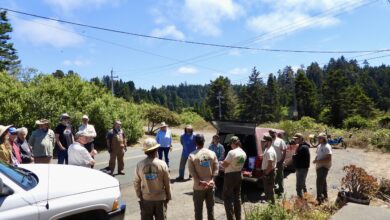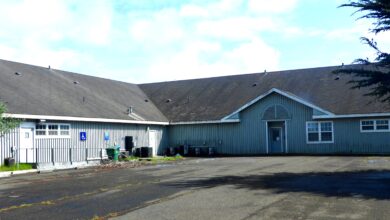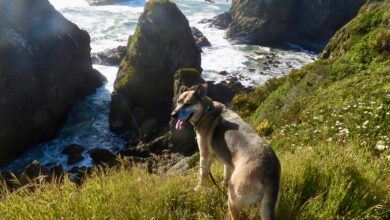State Parks reopens MacKerricher road on Easter Sunday, in addition to other storm-closed parks

CLEONE, 4/7/24 — Like the fabled mountaintop mail carrier, California State Parks crews worked in rain, storm and dark of night to speedily put back the road that connects MacKerricher State Park with Laguna Point. Big storms knocked out that scenic one-mile drive in January. Parks crews and contractors worked through even bigger storms, in the rain over long hours to completely repair and put in new blacktop and road reinforcements. Tourists and campers had been blocked for three months from driving out to the boardwalk, tidepools and sea lion viewing platform at Laguna Point.
On Easter Sunday, State Parks removed the gates. The Laguna Point parking lot has ranged from busy to overfull every day since, with two cars even watching the nonexistent sunset on a storming downpour of a Thursday afternoon.

Mendocino-Sonoma Unit State Parks Chief Ranger Loren Rex said the agency had no choice but to work at breakneck speed. The destruction of the road in January threatened the sewer pipe.

“If we lost that, we might as well close the campground,” he said. The road closed for the first time just before Christmas, when the first big storm dumped tons of sand on the pavement and buried the parking lot at Lake Cleone. On Jan. 13, king tides and a storm ripped out most of the road and road supports. The water overtopped the wooden weir that holds back Lake Cleone but did not destroy the structure. The storms of 2024 did undermine the giant timbers, culvert, asphalt and the undergravel. (See photos).








The MacKerricher campground includes 143 regular spaces and 10 walk- or bike-in camp spaces and can have more than a thousand visitors on a full summer weekend, Rex said.
The ocean dumps sand on the road in every wet year, resulting in closures that usually last a day or two. Never before has the road been lost to this extent.
State Parks has also reopened Russian Gulch, Van Damme and Navarro Beach, all of which also were buried under tons of sand and driftwood, including full-sized trees. State Parks has also removed a romantic bit of littering, the 2,498 padlocks of “love” that had been placed on the Pudding Creek bridge.
Aiding a fad of locking together matching padlocks at a romantic place, bloggers and YouTubers have listed the Pudding Creek Trestle as a great spot to lock and run. Locks of Love has historic roots. The tradition started with a couple meeting on a bridge in the Serbian town of Vrnjacka Banja. Nada and Relja vowed to marry on that bridge. He went off to World War I, married another and never came home. She died still missing him. Afterwards, Serbs locked their locks and threw the keys into the Vrnjacka River to seal their love. This was a phenomenon only in Eastern Europe until Desanka Maksimovic, a noted Serb poet who died in 1993, heard the story of the bridge’s lore and wrote the poem “A Prayer for Love.” That poem is believed to have touched off interest in the tradition, which took off around the world in 2008. On one French bridge the locks’ weight caused one side of the bridge to collapse.
The fad hit a peak before the pandemic. In 2021, when working on a never- published story about the phenomenon, this reporter showed the count done by nephew Joel Hartzell to Rex. Since then state crews have been working steadily to remove them. More than 1,500 had been removed at last check in October, 2023. New locks continue to arrive regularly. The locks had become so thick that they blocked the clear view entirely on much of the west side to youngsters trying to look through the rails out to sea.
State Parks currently faces many severe erosion challenges to its domain, such as more closed areas in Westport area bluff campsites that are driven back by the storms every year. Rex said more than a thousand trees are still damaged, with many dangerous and needing immediate removal or pruning. That has prevented work on the Fern Canyon trail at Van Damme State Park. A trail with a washed-out scenic walking bridge remains closed. Work is continuing to fix up the Mendocino Headlands State Park campground on the east side of Big River Bridge.



State Parks triumphantly took over large swaths of the coast starting in the 1970s and now manages noncontinuous but extensive oceanfront land from Westport to Navarro. Ever since then the thinly stretched agency has been in a pitched battle with the world’s most powerful foe, the Pacific Ocean.
The ocean has been steadily redesigning all of the coastline, especially that north of Fort Bragg, where large amounts of sand end up on the beach after having been moved around Cape Mendocino. A big blow came in 1983 after high waves from a winter storm washed out 20 feet of the road a quarter of a mile north of the Ward Avenue access, preventing lumber trucks from going past that point. The same storm destroyed Point Arena’s fishing pier.
In 1986, any motorist could still enter the MacKerricher Park old Haul Road and drive all the way to the end of Ward Avenue. From there, one could ride a bike all the way to Ten Mile. The road’s owner, Georgia Pacific, fought for permits to rebuild the road and was granted them, but repairs were never made. Now all four miles of the roadway north of Ward is gone. It’s unimaginable that a road went through some parts of that old route, as much of the coast was redesigned by storms in 1989 and 1997. The levee that protects the road to Laguna Point was washed out several times between 1995 and 2005. Each time a herculean effort was made, the levee fixed and the freshwater lake saved from saltwater incursion. But at some point (State Parks personnel cannot remember the year), the damage was too great, and State Parks gave up on keeping the ocean out of the lake. The water is partly brackish now, but is still the source of drinking water for the campgrounds, which is one reason a process is underway to get fresh water further up Mill Creek, Rex said.
The old Union Lumber Haul Road that went from Ten Mile to the mill in the center of Fort Bragg was built as a railroad in 1916 to deliver woodsmen to the remote camps where they lived or to haul logs from Ten Mile River. By 1947, the lumber was mostly gone from that area, most loggers had cars and the camps abandoned. The railroad too was abandoned, and the Haul Road built to accommodate trucks too heavy for the highway. Little by little the endless mills built right down on the ocean to work with floating logs disappeared along the coast north of Fort Bragg. All that land became the nine-mile-long MacKerricher State Park, which stretches from the Glass Beach area to the south side of Ten Mile Bridge, through land donations and land sales. In 1972, a deal was struck for the Haul Road and surrounding areas to end up in State Parks hands, a process concluded in 1995.
The Pudding Creek trestle was also damaged in the early 1980s and was not used until 2007, when State Parks completed a renovation that had cost much more and taken far longer than anyone expected, due to the deterioration of the wood. Five big trestles over the creeks along the way kept the trains running. Now only the Pudding Creek trestle remains, along with a bridge over the road at Laguna Point, the others being replaced by roads — less environmentally friendly than bridges. The Pudding Creek trestle replaced an important crossing of an ancient coastal trail that was used by local Pomo and coastal Yuki tribes for centuries. The Indian trail route ran from somewhere north of San Francisco to Eureka, documented in 1857 by European settlers.

In a June 1949 event celebrated widely in Fort Bragg as the end of the old-fashioned era of logging, the Ten Mile Railroad ran a final excursion for one hundred Fort Bragg residents to witness the loading of the last logging train at Camp 2 along the Ten Mile River and take that last ride to town. The celebration was happy, as it heralded a new higher tech era of logging, where dangerous log jams were a thing of the past and hazardous steam equipment used in the woods was replaced. To demonstrate the new era, new technology tore up all four miles of the rail in two days, to the reported amazement of townsfolk.



The post State Parks reopens MacKerricher road on Easter Sunday, in addition to other storm-closed parks appeared first on The Mendocino Voice | Mendocino County, CA.




